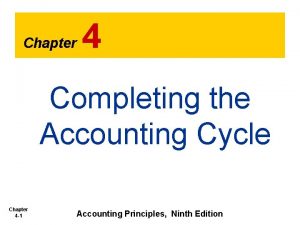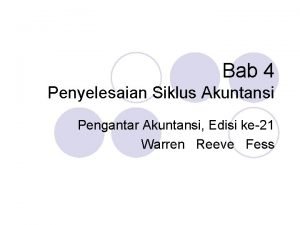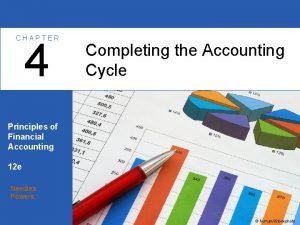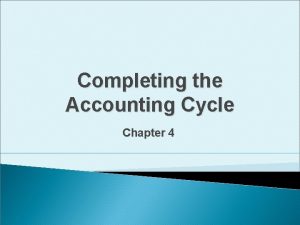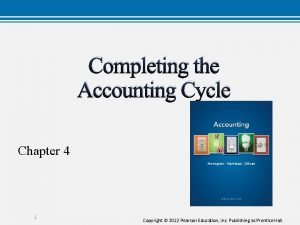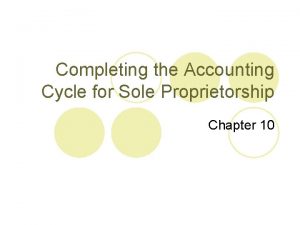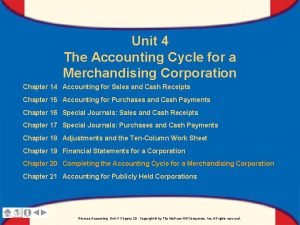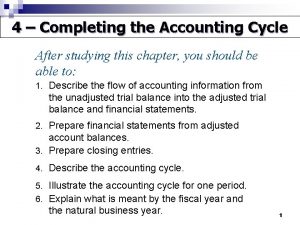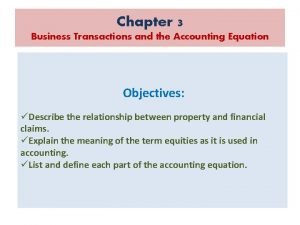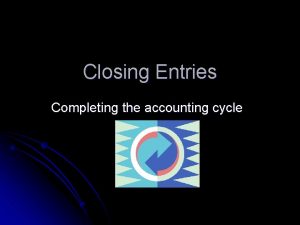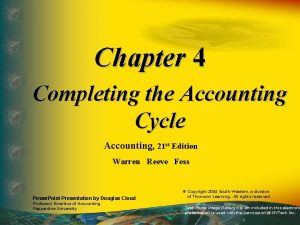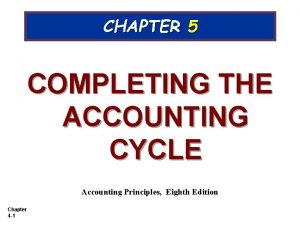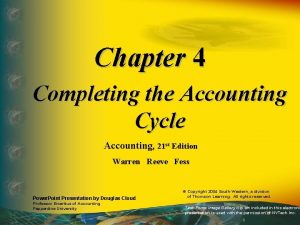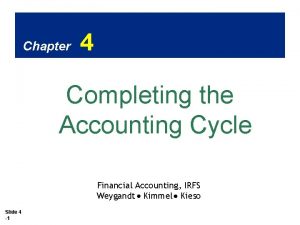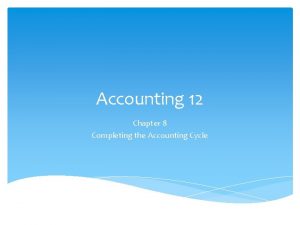CHAPTER 8 COMPLETING THE ACCOUNTING CYCLE preparing for










- Slides: 10

CHAPTER 8 - COMPLETING THE ACCOUNTING CYCLE (preparing for a new year) 8. 1 The Adjustment Process 8. 2 Adjusting Entries and the Worksheet 8. 3 Preparing for New Fiscal Years 8. 4 Adjusting for Depreciation 8. 5 A Spreadsheet for Worksheets

Adjusting the Accounts • Adjusting entry: a journal entry that assigns an amount of revenue or expense to the appropriate accounting period • An entry that brings a balance sheet account to its true value • Every adjusting entry you create will affect at least one income statement account and at least one balance sheet account

Review Adjusting Entries Name the DR and CR accounts 1. Adjusting Supplies DR Supplies Expense Supplies 2. Insurance Expense Prepaid Insurance 3. Late-arriving purchase invoices ie phone, utilities Phone Expense Utilities Expense Accounts Payable 4. Unearned Revenue Fees Earned Unearned Revenue (L) CR

8. 4 Adjusting for Depreciation • Businesses buy durable assets to help produce revenue over several years (known as long-term assets, capital assets, plant and equipment, and property, plant, and equipment) • The income-producing role of property, plant, and equipment spans many years so the cost of purchasing them should be spread out over the length of time that they help produce revenue • Depreciation (also known as amortization): a way of allocating the cost of a long-term asset over its useful, productive life

Example of Depreciation • Assume that a person purchases a new van at a cost of $24, 000 in order to begin a delivery business • After five years, the owner sells the van for $1, 500 • Over the five-year period, the van cost the business $24, 000 less the $1, 500 selling price ($22, 500). • The van helped produce revenue for the business for five years so the cost is spread out over those five years(22, 500 divided by 5 = $4, 500). Meeting the matching principle and time period concept. 2001 2002 2003 2004 2005 $57, 560 $65, 250 $68, 354 $65, 270 $59, 230 Depreciation-Van $4, 500 $4, 500 Other Expenses 36750 38256 39954 42570 45320 Total Expenses $41, 250 $42, 756 $44, 454 $47, 070 $49, 820 Net Income $16, 310 $22, 494 $23, 900 $18, 200 $9, 410 Revenues Expenses

Calculating Depreciation • Depreciation amount is an estimate because a business/accountants can’t wait until the end of an asset’s useful life to figure out an exact amount

Straight-line Method of Calculating Depreciation • Straight-line Depreciation: divides the net cost of the asset equally over the years of the asset’s life Formula: • Straight-line depreciation for one year = original cost of asset – estimated salvage value (what you might sell it for) / estimated number of periods in the life of the asset Adjusting Entry: affects the income statement and balance sheet • Records the depreciation for the period in a depreciation expense account • Increases the appropriate accumulated depreciation account (a contra asset or valuation account) for the asset which reduces the net book value of the asset

Example • A new van is purchased at a cost of $24, 000 in order to begin a delivery business. The van was expected to last five years, at the end of which it would have a trade-in value of $1500. Use the straight-line method to determine the adjusting entry. • Formula = original cost – estimated trade-in value / years of life. (24000 – 1500) / 5 = 4500 Adjusting entry: DR CR Depreciation Expense 4500 Accumulated Depreciation 4500

Adjusting Entry for Depreciation Expense (Income Statement) DR Accumulated Depreciation (Asset) CR To record depreciation • The net book value of an asset would look like this on the balance sheet: Long-Term Assets Truck $78, 000 Less: Accumulated Depreciation 35, 100 $42, 900

Depreciation on the Financial Statements • Depreciation expense is on the income statement • Accumulated depreciation is deducted from its respective asset account on the balance sheet
 Chapter 4 completing the accounting cycle
Chapter 4 completing the accounting cycle Chapter 4 completing the accounting cycle
Chapter 4 completing the accounting cycle Bab 4 menyelesaikan siklus akuntansi
Bab 4 menyelesaikan siklus akuntansi Chapter 4 completing the accounting cycle
Chapter 4 completing the accounting cycle Completing the accounting cycle chapter 4
Completing the accounting cycle chapter 4 Chapter 4 completing the accounting cycle
Chapter 4 completing the accounting cycle Sole proprietorship accounting transactions
Sole proprietorship accounting transactions General ledger merchandising
General ledger merchandising Completing the accounting cycle
Completing the accounting cycle Analyzing business transactions worksheet answers
Analyzing business transactions worksheet answers Financial accounting and accounting standards chapter 1
Financial accounting and accounting standards chapter 1

